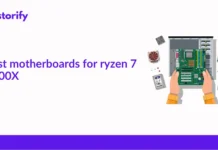Looking for the best graphic cards for VR? Here is our complete list.
Virtual reality technology is already transforming how we interact with games, and in the next years, it will undoubtedly become much more sophisticated and spectacular.
However, if you want to fully experience VR in the meanwhile, you must ensure that you have the appropriate gear, which means investing in the best graphics card for VR in .
Contents
- What Your VR PC Needs: The Minimums
- Top 10 Graphic Cards for VR
- 1. MSI Gaming X GTX 1660 Super
- 2. Sapphire Pulse RX 5600 XT
- 3. EVGA RTX 2070 XC Gaming
- 4. Nvidia GeForce RTX 2070 Super
- 5. XFX Radeon Rx 590 Fatboy
- 6. MSI Gaming GeForce GTX 1650 Graphics Card
- 7. ZOTAC GeForce GTX 1070 Graphics Card
- 8. XFX RX 6800 XT 16GB GDDR6 Graphics Card
- 9. ASUS TUF Gaming GeForce RTX 3080
- 10. MSI Gaming GeForce RTX 3090 Gaming X Trio 24G
- VR Graphic Cards Buying Guide
- 1. VRAM:
- 2. Architecture:
- 3. Ray Tracing:
- 4. Resolution and Frames Per Second:
- Conclusion
What Your VR PC Needs: The Minimums
What will you need if you’re building a gaming PC today to utilize with one of these headsets or upgrading your current desktop to make it VR-ready?
The simple answer is that it requires a good amount of graphic muscle.
The Rift and non-Pro Vive headsets’ resolutions aren’t revolutionary, particularly for PC players who are already used to gaming at considerably higher resolutions of 1440p (2,560 by 1,440 pixels) or 4K. (3,840 by 2,160 pixels).
However, the 90Hz refresh rate required for VR headsets implies that your games must operate at or near 90 frames per second (fps), or preferably higher, in order to appear as fluid as possible.
Do not minimize the importance of that: Smooth frame rate performance is critical in VR, since judder and screen tearing may induce dizziness and nausea when moving your head around in a virtual environment.
The HTC Vive and Vive Pro need a minimum of an Intel Core i5-4590 or an AMD FX-8350 or higher CPU.
In general, any current Core i5 or Core i7 desktop CPU, such as the Intel Core i5-11600K or one of AMD’s Ryzen 7 processors, should suffice.
Given the similarities between the original Vive and the Rift displays, it’s unsurprising that Oculus’ stated minimum Rift requirements contain the same Intel CPU recommendations.
You’ll also require 16GB or more RAM for either HMD, but 4GB is the absolute minimum for the Vive and 8GB for the Rift.
If you want to avoid standing in virtual darkness for extended periods of time as your game’s levels load, we’d also highly suggest installing a solid-state drive (SSD) in any VR-ready machine.
However, the graphics card is the critical component of hardware. If you’re using an earlier video card with the Index, original Vive, or Rift (including the Rift S), you’ll want to upgrade to a GeForce GTX 1060 from Nvidia or an AMD Radeon RX 580, Radeon RX 590, or Radeon RX Vega card.
The GeForce GTX 1050 and GTX 1050 Ti are insufficient for the Vive, although an even older-generation GeForce GTX 970/980 or Radeon R9 290/390 may suffice. The Rift and Rift S need a GeForce GTX 1050 Ti as a bare minimum.
With newer GPUs, you want to start with a Radeon RX 5600 Series or a GeForce GTX 1660 Ti.
Alternatively, any of the GeForce RTX GPUs will suffice. (I’ll return to them in a minute.)
You’ll want to check somewhat higher up the card stacks for the Vive Pro or newer Vive Cosmos HMDs; the squeak-by cards are the same as for the standard Vive, but the suggested baseline is higher.
Top 10 Graphic Cards for VR
1. MSI Gaming X GTX 1660 Super
NVIDIA’s GTX 1660 Super is a good example of a quality VR graphics card for around $ 300. It has the same Turing architecture as current RTX cards but lacks specialized ray-tracing processors and DLSS 2.0 support for ordinary gameplay.
In any event, it will still provide a high-quality VR experience for the majority of headsets and games, but at a lower resolution or frame rate.
MSI Gaming X has 336 GB per sec memory bandwidth, 1,830 MHz boost clock speed. 192 bit memory bus and 6 GB of GDDR6 VRAM.
These are really remarkable statistics considering the price of these cards, which operate at a rather efficient 125W. When not in virtual reality, the GTX 1660 Superpowers fluid 1080p gaming on a monitor.
NVIDIA G-Sync technology aids in the reduction of stuttering and tearing.
2. Sapphire Pulse RX 5600 XT
It is an outstanding choice that competes on raw performance with NVIDIA’s RTX 2060 Super. It lacks RTX features like ray tracing and DLSS 2.0 but comes at a lower price.
If you’re not concerned with pushing the boundaries of current virtual reality headsets but still want a pleasant experience, this card should be an excellent addition to your PC.
We suggest the Sapphire Pulse version since it comes with 192-bit memory bus, 336 GB per second memory bandwidth, and 6 GB GDDR6 VRAM.
When not in VR, this GPU is capable of 1440p on a normal monitor, however, it is recommended to disable this feature to provide a top-tier 1080p experience.
3. EVGA RTX 2070 XC Gaming
Then there’s the EVGA RTX 2070 XC Gaming GPU, which utilizes Nvidia’s new Turing architecture as well.
Fortunately for anybody interested in purchasing one, it is also reasonably priced, which is advantageous given how expensive many high-quality GPUs are.
While this solution is not at the top of the pyramid, it is still very fast and powerful, and it is more than capable of providing you with a 90 FPS VR experience.
EVGA RTX 2070 comes fitted with Dual HDB fans to boost performance and cool down the system with quite acoustic noise. It has adjustable RGB LED lighting that fits across any PC.
One of the USPs of RTX 2070 is its clock speed. This graphic card clocks at a speed of 1710 MHz. It comes in various variants depending on the fan size, heatsink size and ultra-cooling technologies.
4. Nvidia GeForce RTX 2070 Super
To be quite candid, this is the most expensive option, even when compared to the prior two. However, the majority of other top-tier GPUs are much more costly, making this a great option that delivers excellent performance at a fraction of the price.
In other words, this GPU serves as a substitute for those that are too expensive. However, the manufacturer did not commit an error in naming it super.’
It seems to be a carbon duplicate of the Nvidia GeForce RTX 2080, but at a considerably cheaper price and with a slightly higher GPU clock increase.
Additionally, it features a few fewer computing cores – 2560 as opposed to 2,944. Everything else is almost similar, including dimensions, transistor count, power needs, and fan count.
5. XFX Radeon Rx 590 Fatboy
XFX is an amazing graphics card that is best suited for AMD Radeon processors.
As implied by its name, this graphics card has 8GB of DDR5 memory, which is plenty for 1080p gameplay. Additionally, it is an overclocked variant, which means you may obtain greater clock rates than the regular version, which runs at 1570 Mhz.
This GPU struggles with 1440p gaming but excels at 1080p. Aesthetically, the XFX Rx 590 is similar to the Rx 580, with the same black and red color scheme and a rear-side backplate. This graphics card requires a six-pin and one eight-pin power connection and has a TDP of 175 W.
6. MSI Gaming GeForce GTX 1650 Graphics Card
This cheap graphics card delivers an acceptable experience when used with virtual reality headsets. The graphics card is equipped with an Nvidia chipset that includes a turning encoder.
It has a 4 GB GDDR6 memory and a 128-bit memory interface. Additionally, it has a 1620 MHz boost clock.
The graphics card is loaded with features, including adaptive shadowing, parallel operation execution, and unified memory architecture. With these enhancements, the GPU has double the cache of its predecessor and consumes 1.4x less power.
The graphics card operates quietly and does not overheat, ensuring a smooth VR experience.
7. ZOTAC GeForce GTX 1070 Graphics Card
Here’s another VR-ready GPU from ZOTAC. It has an 8 GB DDR5 VRAM module with an 8000 MHz memory speed. It is capable of handling the majority of your VR activities with ease.
The gadget is small and straightforward to install. Additionally, it has a boost clock of 1708Mhz, which is very remarkable.
The ZOTAC GeForce GTX is a Pascal-based graphics card. This pascal design is compatible with virtual reality and ultra-high-resolution systems.
Additionally, it enables 360-degree picture capturing even when used in conjunction with a virtual reality interface. Additionally, this GPU supports all DirectX 12 capabilities, resulting in a more fluid and powerful experience.
8. XFX RX 6800 XT 16GB GDDR6 Graphics Card
Similar to how the 3080 serves as Nvidia’s second in command, the 6800 XT serves as AMD’s counterpart. It has all of the architectural beauty of its superior, but with somewhat fewer capabilities and a lower price tag.
Expect a little drop in frame rates, particularly at higher resolutions, but those VR worlds will still be rendered with such realism that you’ll wonder why you ever put on the headset in the first place.
It gives the game clock speed of 2015 MHz and Boost clock of about 2259 MHz with 15 GB Memory speed that makes it perfect for 4k Gaming. The new generation of Graphic card VR gives ultimate experience in every frame.
9. ASUS TUF Gaming GeForce RTX 3080
The RTX 3080 is a little downgrade from the 3090, but it retains everything of the 3090’s technology, including 2nd-gen hardware ray tracing, low-latency performance, accelerated RT VR audio, and pure variable-rate shading.
It even has the same third-generation Tensor cores that power AI deep learning. The RTX 3080 may not be able to match the RTX hegemon frame for frame, but it still delivers perfect 4K performance, which means setting up your VR set will be a breeze, and it comes with a little more affordable price tag. Hurray!
10. MSI Gaming GeForce RTX 3090 Gaming X Trio 24G
In terms of graphics performance, the RTX 3090 is unmatched, and the MSI Trio X is one of the most remarkable versions presently available. Despite the high 370-watt PSU draw, this card runs very coolly with three FROZR 2 fans whirling away.
Not only is this capable of VR resolutions, but you can also run your favorite games at 8K with the 24 GB GDDR6 VRAM memory setup! This ensures that your VR frame rates will never go below the minimum of 90 frames per second, even at the GPU’s lowest rate.
VR Graphic Cards Buying Guide
VR gaming through Head-Mounted Displays (HMDs) or VR PC gaming? The choice is entirely yours. However, the basic characteristics of Virtual Reality gaming in all situations are quite similar. It does take some care to get the most out of it, which makes upgrading your PC worthwhile.
Although the best graphics card for VR stated before handled both of these scenarios. All you have to do is determine your need for a VR GPU, the level of performance you are prepared to accept, and most crucially, your budget.
If you’re searching for a virtual reality graphics card for virtual reality headsets, you can find the system requirements for them, including the minimum VR GPU need, here:
1. The minimum requirement for a virtual reality graphics card for Windows Mixed Reality Headsets
2. Minimum need for HTC Vive, Vive Pro, and Vive Cosmos VR graphics cards
3. Valve Index requires a VR graphics card.
4. Oculus Rift requires a VR graphics card (& S)
5. It’s worth noting that gaming with a VR headset requires a bit more frame rate push; ideally, a 90Hz refresh rate is required to get the VR performance up to a respectable and acceptable level, as opposed to the 60Hz typical refresh rate for regular PC gaming.
However, that is not the end of the tale when it comes to the significance of refresh rate for virtual reality; given how rapidly VR technology is advancing and dominating at the moment, your standard or priority should also be high.
Upgrading your PC is not something you do often, but it does give you a chance to unwind after spending money on the fundamental components, so why not get something futuristic?
This implies that the GPU you purchase must be capable of effortlessly running both current and older games.
For this, the RTX 3080 and RX 6800 seem to be the optimal choices. Although both the RX 5700 XT and the RTX 2070 Super are capable of pulling the proper strings for virtual reality gaming.
If your budget is restricted, the scenario is still favorable, since there are a few mid-range VR graphics cards available, such as the GTX 1660 Ti and RX Vega 56.
Additionally, the GTX 1060 and RX 590 fill a need for those with the smallest budgets as a low-cost VR graphics card at a time when upgrading a graphics card involves taking your boots off.
After identifying the best graphics card for VR, the next steps are required:
When purchasing a graphics card, examine the dimensions to see whether it fits comfortably in your tower or if you’ll need to update your PC case as well.
To prevent any difficulty, we recommend purchasing the appropriate GPU in the first place.
Similarly, the ports and connections must be similar for the remainder of your PC’s components. Not only is it necessary to complete the task at hand, but it also provides for the optimal refresh rate and load capacity for the components.
Inspect the GPU’s cooling mechanism, including the number of fans, the power supply, and the graphics card’s thermal design power.
If the graphics card’s power consumption is incompatible with the PC’s total power supply, it will almost certainly result in inefficient heat dissipation, the underperformance of the components, increased power consumption, and even system failure.
Am I purchasing a new graphics card just for VR or is there more to it? You have to ask yourself this question, gentlemen.
If you’re a gamer with professional baggage on your back, you need to look beyond the standard, or should we say low-cost, graphics card. That is anything that provides the appropriate level of virtual immersion while still being capable of handling heavy multitasking is critical.
Then cheap graphics cards are not for you, and you should avoid them entirely.
We think you have previously addressed the VRAM and GPU clock speed. As it is more likely to be determined by the task at hand, the reason for utilizing a specific graphics card aids in selecting the appropriate quantity of video RAM and clock speed.
In summary, the more intensive and professional the job, the greater the need for memory and its speed.
At times, making the correct decision may be very perplexing. This is why we’ve included a detailed list of things to consider while buying the graphic cards for VR:
1. VRAM:
While standard VR gaming does not need a large amount of VRAM because of the lower resolutions of VR displays compared to desktop monitors, having at least 4GB will guarantee textural components are optimal.
On the other hand, if you want to produce a picture sharper than the native resolution of the VR set, a process known as supersampling, you will need a considerably bigger and faster VRAM.
2. Architecture:
The GPU architecture is comprised of an enormous number of cores. In general, the more cores, the faster the GPU, although this is not always the case.
Each successive generation of design improves the performance of individual cores, requiring fewer to do the same task. Having said that, newer architecture does not necessarily imply improved performance.
There is usually some overlap across GPU families, which means that the top of one generation is always better at gaming than the entry-level and sometimes mid-range GPUs of the next.
While newer architectures are preferable for VR, never overlook the preceding generation’s champions.
3. Ray Tracing:
Ray tracing is a real-time rendering technique that produces eerily realistic lighting effects in games; thus, if you want your virtual reality to be as real as possible technologically, a GPU with hardware ray tracing capabilities is required.
It’s worth noting, though, that activating ray tracing may have a negative impact on frame rate, which is why you’ll need a powerful GPU to pull it off properly.
It would very likely be pointless to use software ray tracing in VR with older GPUs since the quality loss would be too great.
4. Resolution and Frames Per Second:
The majority of contemporary virtual reality headsets, whether manufactured by Oculus, HTV, Sony, or Google, have a 2160 x 1200 pixel resolution and a 90Hz refresh rate on an OLED display.
That implies that in order to play VR games properly, your graphics card must be capable of at least 90 frames per second.
Indeed, it is preferable if it averages out much higher than that to avoid lows ever dropping below the 90 fps threshold.
Conclusion
To summarize, Sony’s PlayStation VR has also drawn a large number of developers to VR development, which helps us, PC players.
A VR setup is often more expensive than a standard gaming rig, owing to the more demanding specifications and the extra cost of the VR headset.
Nonetheless, virtual reality gaming does not have to be prohibitively costly. If your budget is limited, go for the GTX 1060 GPU, which will enable you to play VR games in .
On the other hand, if your money is limitless, the RTX 2080 Ti is hands down the finest GPU for VR gaming and general computing.
Also Read:
- 8 Best Graphics Card for Video Editing Without Lags or Delay
- 9 Easy Methods to Run High-End Games Without Graphics Card
-
10 Best Gaming Motherboard of : Enhance Your Gaming Experience
























